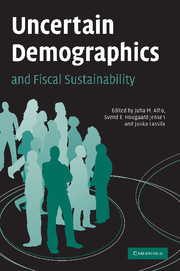Book contents
- Frontmatter
- Contents
- List of figures
- List of tables
- List of contributors
- Preface
- 1 Introduction
- Part I Uncertain demographics
- Part II Measuring sustainability in a stochastic environment
- Part III Enhancing sustainability
- Part IV Extensions
- 10 Macro-economic consequences of demographic uncertainty in world regions
- 11 Informational assumptions, aggregate mortality risk and life-cycle saving
- 12 Uncertain demographics, longevity adjustment of the retirement age and intergenerational risk-sharing
- 13 A general equilibrium analysis of annuity rates in the presence of aggregate mortality risk
- Comment: The economics of demographic uncertainty
- Index
- References
10 - Macro-economic consequences of demographic uncertainty in world regions
Published online by Cambridge University Press: 22 September 2009
- Frontmatter
- Contents
- List of figures
- List of tables
- List of contributors
- Preface
- 1 Introduction
- Part I Uncertain demographics
- Part II Measuring sustainability in a stochastic environment
- Part III Enhancing sustainability
- Part IV Extensions
- 10 Macro-economic consequences of demographic uncertainty in world regions
- 11 Informational assumptions, aggregate mortality risk and life-cycle saving
- 12 Uncertain demographics, longevity adjustment of the retirement age and intergenerational risk-sharing
- 13 A general equilibrium analysis of annuity rates in the presence of aggregate mortality risk
- Comment: The economics of demographic uncertainty
- Index
- References
Summary
Introduction
Demographic projections suggest that the OECD countries (notably the European countries and Japan) are expected to have large increases in their old-age dependency ratios. The other regions of the world are expected to have relatively low ratios, and their working-age populations are expected to increase. This differential timing of ageing may induce international flows of ‘excess’ saving from the ageing industrialized regions to the younger developing regions during the next decades. We expect such macro-economic dynamics – more precisely the saving-investment equilibrium – to be reflected in the world financial markets, in particular in the evolution of world interest rates.
While demographics have long been identified as a key variable in long-term macro-economic analysis, most previous analyses have relied on deterministic population forecasts. But, as contributions in this volume testify (e.g. Keilman, Cruijsen and Alho, chap. 2; Alho, Cruijsen and Keilman, chap. 3), demographic developments are uncertain, and attempts at describing this via scenario-based variants have serious shortcomings. As far as we know, the macro-economic consequences of demographic uncertainty have not been explored in the multi-regional setting of the world economy, but they can be of considerable interest. The asynchronous nature of the ageing process is expected to influence macro-economic trends, but it is also of interest that the uncertainty of population forecasts differs across world regions (National Research Council, 2000).
In this chapter, we investigate the impact of demographic uncertainty in a multi-regional general equilibrium, overlapping-generations model.
- Type
- Chapter
- Information
- Uncertain Demographics and Fiscal Sustainability , pp. 195 - 218Publisher: Cambridge University PressPrint publication year: 2008
References
- 1
- Cited by



